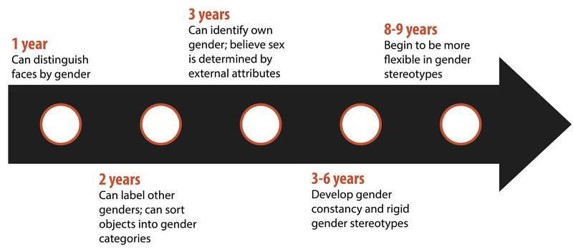Sex and Gender
Sex refers to biological, physical and physiological differences between males and females, including both primary sex characteristics (the reproductive system) and secondary characteristics such as height and muscularity, as well as genetic differences (e.g., chromosomes). Male sexual and reproductive organs include the penis and testes. Female sexual and reproductive organs include clitoris, vagina and ovaries. Biological males have XY chromosome and biological females have XX chromosome but biological sex is not as easily defined or determined as you might expect. For example, does the presence of more than one X mean that the XXY person is female or does the presence of a Y mean that the XXY person is male? The existence of sex variations fundamentally challenges the notion of a binary biological sex.
In humans, intersex individuals make up about two percent, more than 150 million people, of the world’s population (Blackless et al., 2000). Intersex describes variation in sex characteristics, such as chromosomes, gonads (testes and ovaries), sex hormones, or genitals (penis, clitoris, vulva). The term is misleading because it suggests that people have complete sets male or female reproductive systems but this is not always the case. There are dozens of intersex conditions, such as Androgen Insensitivity Syndrome and Turner’s syndrome (Lee et al., 2006).
In our example, having one Y and more than one X chromosome is called Kleinfelter Syndrome. Some people have genitalia considered ambiguous, meaning that they cannot easily be identified as either male (penis) or female (clitoris). Fausto-Sterling (2000) argues that the decision to label someone male or female is a social decision and that a biological sex is too complex to fit within a binary sex system. Nevertheless, because assigning a sex identity is a fundamental cultural priority, doctors will typically decide, with respect to intersex babies, within 24 hours of a birth. Sometimes this decision involves surgery, which can have long term psychological consequences (Fausto-Sterling, 2000).
Gender
Gender is a term that refers to social or cultural distinctions and roles associated with being male or female. Gender is not determined by biology in any simple way. At an early age, we begin learning cultural norms for what is considered masculine (trait of a male) and feminine (trait of a female). Gender is conveyed and signaled to others through clothing and hairstyle, or mannerisms like tone of voice, physical bearing, and facial expression. For example, children in the United States may associate long hair, fingernail polish or dresses with femininity. Later in life, as adults, we often conform to these norms by behaving in gender specific ways: men build houses and women bake cookies (Marshall, 1989; Money et al., 1955; Weinraub et al., 1984). It is important to remember that behaviors and traits associated with masculinity and femininity are culturally defined. For example, in American culture, it is considered feminine to wear a dress or skirt; however, in many Middle Eastern, Asian, and African cultures, dresses or skirts (often referred to as sarongs, robes, or gowns) are worn by males and are considered masculine. The kilt worn by a Scottish male does not make him appear feminine in his culture.

Our understanding of gender begins very early in life – often before we are born. Western cultures, expecting parents are asked whether they are having a girl or a boy and immediately judgments are made about the child. Boys will be active and presents will be blue while girls will be delicate and presents will be pink. In some Asian and Muslim cultures a male child is valued more favorably than a female child (Matsumoto & Juang, 2013) and female fetuses may be aborted or female infants abandoned.
Children, by their first birthday, already distinguish faces by gender and between 3 and 6 years of age, children develop strong and rigid gender stereotypes. Gender stereotyping involves overgeneralizing about the attitudes, traits, or behavior patterns of women or men. Stereotypes can refer to play (e.g., boys play with trucks, and girls play with dolls), traits (e.g., boys are strong, and girls like to cry), and occupations (e.g., men are doctors and women are nurses). These stereotypes stay rigid until children reach about age 8 or 9. Then they develop cognitive abilities that allow them to be more flexible in their thinking about others.


